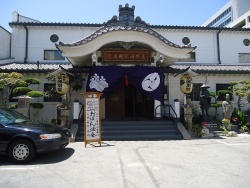Koyasan Buddhist Temple
Koyasan Beikoku Betsuin (高野山米国別院 Kōyasan Beikoku Betsuin?, "Koyasan United States Branch Temple"), also known as Koyasan Buddhist Temple, is a Japanese Buddhist temple located in Los Angeles, California, USA, in Little Tokyo.
Founded in 1912, it is one of the oldest existing Buddhist temples in the North American region.
The temple is a branch of the Koyasan Shingon Buddhism sect, and is the North and South American regional headquarters for this sect.
History
The temple was founded by the Reverend Shutai Aoyama, a native of Toyama Prefecture, who was sent by the Koyasan headquarters to establish a global link in Shingon Buddhism in America.
Initially facing personal hardship in establishing a temple in his inaugural arrival, he founded the temple in 1912 with the assistance of Issei and Nisei temple members, and established its first location in a storefront in 1912 near Elysian Park.
In 1920, the temple was moved to a larger building Central Avenue.
A tree was planted in front of the new building by Koyasan Temple members to commemorate the move.
Today it is known as the Aoyama Tree, a notable landmark in Little Tokyo, and the Japanese American National Museum stands where Koyasan's second location once stood.
The Aoyama Tree was given historical status by the Los Angeles City Council in 2008.
The third and current building located on East 1st Street was built in 1940.
One year after its establishment, Japan attacked Pearl Harbor, sparking the United States' involvement in World War II.
The new temple was closed while its members were forcibly relocated in the various internment camps.
During the time period of World War II, the temple was mostly used for storage space for internees.
The temple was re-opened in 1946; from which that point on, the temple had to rebuild its congregational base after families and residents of Little Tokyo were scattered outside Los Angeles.
Over the years, the temple began opening cultural and religious programs and classes for the local community.
As early as the 1950s to the 1980s, Koyasan Temple was the main hub of Japanese cultural events in Little Tokyo.
Starting in 1999, the temple underwent a ten-year renovation of the old facilities to meet with the city building codes; the building was especially retrofitted to fit the needs for the monthly Goma fire ritual service.
In 2011, the temple underwent a leadership crisis when Bishop Seicho Asahi resigned his post due to conflicts of interest and health reasons.
To meet with the temple's demands, the previous Bishop Taisen Miyata as well as two priests from Koyasan were brought in to assist the temple.
The temple celebrated its centennial in November 2012.
Renowned goma fire ritual master Ekan Ikeguchi was invited to preside over the service.
Bishops
The temple has had eight head bishops since its inception in 1912.
The fourth and fifth bishop, Reverends Seytsu Takahashi and Ryosho Sogabe, pioneered the founding the temple building as it stands today; Takahashi later became the vice-abbot of Kongobu-ji in Mount Koya.
Reverend Taido Kitagawa was the father of local record producer Johnny Kitagawa, as well as a co-organizer of the temple's Boy Scout Troop 379.
The recent bishop was Reverend Seicho Asahi, the former head bishop of the North California Koyasan Temple who served from 2007 until he resigned in 2011.
Taisen Miyata, the seventh bishop and a well known translator of Esoteric Buddhist texts, took his place as acting bishop in mid-2011.
- Rev. Shutai Aoyama (1909-1921)
- Rev. Hokai Takada (1921-1924)
- Rev. Taido Kitagawa (1924-1933)
- Rev. Seytsu Takahashi (1931-1982)
- Rev. Ryosho Sogabe (1982-1991)
- Rev. Chiko Inouye (1991-1993)
- Rev. Taisen Miyata (1993-2007, acting: 2011-2013)
- Rev. Seicho Asahi (2007-2011)
Boy Scout Troop 379
The temple is also home to Boy Scout Troop 379, formed in 1931, one of the oldest troops in existence in California.
Future actor and gay rights activist George Takei was one of the troop's first members.
